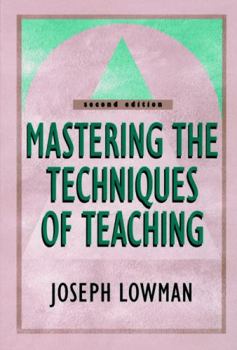Mastering the Techniques of Teaching
Select Format
Select Condition 
Book Overview
Now in Paperback! "Masterfully balancing the practitioner's need for concretesuggestions and the scholar's quest for intriguing ideas, this bookoffers tips to be tried in class tomorrow and ideas to be mused onfor months."
--Maryellen Weimer, professor, Penn State University-BerksCampus "I have used the first edition of Joe Lowman's book for years andfound it most helpful. The new edition is a must for teachers andfaculty developers."
--Milt Cox, University Director for Teaching Effectivness Programs, Miami University In this second edition of his classic resource, Joseph Lowmanexpands on his earlier model of effective teaching to place greateremphasis on motivational skill and commitment to teaching. Hepresents a practical new learning model that compares six sourcesof influence on what and how students learn in a college course.All types of teachers and instructors will discover options on howto organize classes and use group work to promote learning. Theywill also find a checklist for assessing their classroomperformance on video, detailed instructions for using videoanalysis to improve their technique, and an innovative approach toevaluating their overall performance.
--Maryellen Weimer, professor, Penn State University-BerksCampus "I have used the first edition of Joe Lowman's book for years andfound it most helpful. The new edition is a must for teachers andfaculty developers."
--Milt Cox, University Director for Teaching Effectivness Programs, Miami University In this second edition of his classic resource, Joseph Lowmanexpands on his earlier model of effective teaching to place greateremphasis on motivational skill and commitment to teaching. Hepresents a practical new learning model that compares six sourcesof influence on what and how students learn in a college course.All types of teachers and instructors will discover options on howto organize classes and use group work to promote learning. Theywill also find a checklist for assessing their classroomperformance on video, detailed instructions for using videoanalysis to improve their technique, and an innovative approach toevaluating their overall performance.
Format:Paperback
Language:English
ISBN:078795568X
ISBN13:9780787955687
Release Date:January 1995
Publisher:Jossey-Bass
Length:368 Pages
Weight:1.11 lbs.
Dimensions:1.0" x 5.9" x 9.0"
Customer Reviews
3 ratings
Fantastic advice!
Published by Thriftbooks.com User , 16 years ago
I wish I'd read this book when I first started teaching 8 years ago--I would have been able to avoid some of my early mistakes and optimized my interaction with students even earlier! Also highly recommended for those who train new instructors!!!
The Teacher is Both Host and Guest . . .
Published by Thriftbooks.com User , 17 years ago
I was turned onto this great book by a former instructor in pedagogy, whom I felt was a great teacher in his own right, a relevant and profound authority, and I am ever grateful. Lowman begins from this definition: "A classroom is an emotionally charged interpersonal arena in which a wide range of psychological phenomena occur." Also, he begins with a challenge: "Beyond a solid mastery of one's subject, college teaching of the highest order appears to be a complex task requiring the ability of communicate well with students, whether in large or small groups or in formal or informal settings, and to relate to them as people in ways they find positive and motivating." The classroom is thus a diverse, and ever changing series of contexts for human action, reflecting the blossoming of relationships between teacher and students. As teachers, we want to inspire. But, in order to achieve this end, we must pursue a rational approach. We must adhere to specific, tested strategies and principles. Lowman's strength is in his ability to chart in clear and ordered contours a path to recognition of the best course of action to be taken in each given context to achieve maximum student motivation. He establishes the instructional qualities that have, over time, been proven to comprise exemplary teaching and proceeds to demonstrate how they can be developed. The text is well-organized in 10 chapters which outline these qualities in progression: 1)What Constitutes Exemplary Teaching? 2)Understanding Classroom Dynamics 3) Developing Interpersonal Skills and Teaching Style 4)Analyzing and Improving Classroom Performance 5)Selecting and Organizing Material for Classroom Presentations 6)Enhancing Learning Through Classroom Discussion 7)Planning Course Content and Teaching Techniques to Maximize Interest 8)Integrating Learning In and Out of the Classroom 9) Evaluating Student Performance 10)The Art, Craft, and Techniques of Exemplary Teaching. He references a number of interesting sources, of which two impressed me as being of primary importance: the 1970 Mann Group Study and a book by Duffy and Jones, entitled 'Teaching Within the Rhythms of the Semester' (1995). Although I'm not crazy about typologies, I found the Mann Group findings truly helpful in dealing with the continual flux of people that come to my classroom, each with varying presuppositions, life challenges, and diverse backgrounds, which must be sorted and dealt with quickly and effectively in creating positive learning environments. The Mann typing of students gives a quick and accurate paradigm for categorizing behavior which I've found very useful for building community in the classroom. Lowman's ability to apply pedogagic studies such as these to specific contexts that arise in the course of instruction puts the methodology of teaching on a series of grids - which have the cumulative effect of locating for the aspiring teacher an easily referenced modus operandi which leads to classroom su
Very useful descriptions of masterful University teaching.
Published by Thriftbooks.com User , 25 years ago
This book provides examples of inspirational teaching and techniques for reaching students. For me it ranks up there right next to Wilbert McKeachie's "Teaching Tips".





